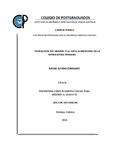| dc.contributor.author | Alfaro Izarraraz, Rafael | |
| dc.creator | ALFARO IZARRARAZ, RAFAEL; 307017 | |
| dc.date.accessioned | 2019-07-29T17:53:37Z | |
| dc.date.available | 2019-07-29T17:53:37Z | |
| dc.date.issued | 2016-07 | |
| dc.identifier.uri | http://hdl.handle.net/10521/3716 | |
| dc.description | Tesis (Doctorado en Ciencias, especialista en Estrategias para el Desarrollo Agrícola Regional).- Colegio de Postgraduados, 2016. | es_MX |
| dc.description.abstract | El hambre surge como una manera de aceptar que los que ocupan la parte baja de la escala social deben sacrificarse, ante las metas que ha fijado el poder terrenal que se ha instalado como poder dominante al interior de la sociedad. Las metas pueden ser la vida eterna, el progreso o la globalización. El poder terrenal tiene su origen en el surgimiento de la conciencia del ser, que se apartó del fluir eterno que lo condenaba a un “instante”: a vivir y morir. Vivir con hambre fue una condición impuesta por el poder que fijo sus propias metas, pero sometiendo al sufrimiento a la población como condición para poder alcanzar los beneficios que traerían la consecución de esas metas. En realidad el propósito fue que en tanto a unos la narrativa mitológica, religiosa y del progreso los condicionaba a vivir con hambre, quienes ocuparon la parte alta de la escala social disfrutan del placer que otorga el ocupar un lugar privilegiado en la escala, que permite valorar y controlar los alimentos. Se expone la manera en que, en la sociedad industrial, los que ocupan la parte baja de la escala social se opusieron a esa condición de vivir con hambre llevando a cabo revoluciones sociales. Las políticas establecidas por el modelo keynesiano de economía que atenuó el hambre en el mundo, tratando de blindar a la población contra el comunismo. Se analiza la reinstalación del poder de clase y el hambre, al concluir el siglo XX e iniciar el XXI. Finalmente, se hace un estudio de la configuración de la Sierra Negra poblana, como un reservorio de mano de obra barata, cuya población es condicionada a vivir con hambre, con el propósito de servir a una economía agrícola local y del norte del país. _______________ GENEALOGY OF HUNGER AND FOOD DIET IN SIERRA NEGRA POBLANA. ABSTRACT: Hunger emerges as a way to accept that those who occupy the bottom of the social scale must sacrifice, to the goals set by the earthly power has been installed as the dominant power within society. Goals can be eternal life, progress or globalization. Earthly power is rooted in the rise of consciousness of being, which is eternal flowing away moved aside from condemning to a "moment" to live and die. Living with hunger was a condition imposed by the power set their own goals, but subjecting the population to the suffering as a condition to achieve the benefits that would bring the achievement of those goals. In fact, the purpose was that while some mythological, religious and progress narrative conditioned them to live with hunger, those who occupied the top of the social ladder enjoy the pleasure given by occupying a privileged place in the scale, which allows assess and control food. The industrial society, those in the bottom of the social scale rejected the condition of living with hunger carrying out social revolutions opposed exposed. The policies set by the Keynesian economy model eased hunger in the world, trying to shield the population against communism. The reinstallation of class power and hunger, at the end of the twentieth century and begin the XXI is analyzed. Finally, a study of the configuration of the Sierra Negra poblana as a reservoir of cheap labor, whose population is conditioned to live with hunger, with the purpose of serving a local agricultural economy and the north. | es_MX |
| dc.description.sponsorship | Consejo Nacional de Ciencia y Tecnología (CONACyT). | es_MX |
| dc.format | pdf | es_MX |
| dc.language.iso | spa | es_MX |
| dc.rights.uri | http://creativecommons.org/licenses/by-nc-nd/4.0 | es_MX |
| dc.subject | Castigo | es_MX |
| dc.subject | Dieta | es_MX |
| dc.subject | Disciplina | es_MX |
| dc.subject | Hambre | es_MX |
| dc.subject | Poder | es_MX |
| dc.subject | Sierra negra poblana | es_MX |
| dc.subject | Diet | es_MX |
| dc.subject | Discipline | es_MX |
| dc.subject | Hunger | es_MX |
| dc.subject | Power | es_MX |
| dc.subject | Punishment | es_MX |
| dc.subject | EDAR | es_MX |
| dc.subject | Estrategias para el Desarrollo Agrícola Regional | es_MX |
| dc.subject | Doctorado | es_MX |
| dc.subject.classification | CIENCIAS SOCIALES::SOCIOLOGÍA::PROBLEMAS SOCIALES::HAMBRE | es_MX |
| dc.title | Genealogía del hambre y la dieta alimentaria en la sierra negra poblana. | es_MX |
| dc.type | Tesis | es_MX |
| Tesis.contributor.advisor | Ramírez Juárez, Javier | |
| Tesis.contributor.advisor | Bustamante González, Ángel | |
| Tesis.contributor.advisor | Vargas López, Samuel | |
| Tesis.contributor.advisor | Paredes Sánchez, Juan Alberto | |
| Tesis.contributor.advisor | Medina Ciriaco, Susana | |
| Tesis.date.submitted | 2016-07 | |
| Tesis.date.accesioned | 2016 | |
| Tesis.date.available | 2016 | |
| Tesis.type | Tesis | es_MX |
| Tesis.format.mimetype | pdf | es_MX |
| Tesis.format.extent | 3,019 KB | es_MX |
| Tesis.subject.nal | Temor | es_MX |
| Tesis.subject.nal | Fearfulness | es_MX |
| Tesis.subject.nal | Ingestión | es_MX |
| Tesis.subject.nal | Desnutrición | es_MX |
| Tesis.subject.nal | Malnutrition | es_MX |
| Tesis.subject.nal | Puebla, México | es_MX |
| Tesis.rights | Acceso abierto | es_MX |
| Articulos.subject.classification | Hambre colectiva | es_MX |
| dc.type.conacyt | doctoralThesis | es_MX |
| dc.identificator | 5||63||6310||631004 | es_MX |
| dc.contributor.director | RAMÍREZ JUÁREZ, JAVIER; 15765 | |
| dc.audience | generalPublic | es_MX |


